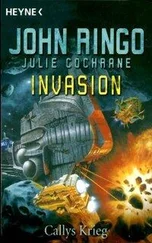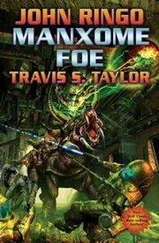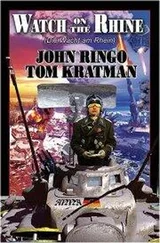“I don’t know, sir. I’m a data collector and analyst not an exoroboticist. But this is just one image. Look at this one.” Carolyn tapped the touchpad button.
“Hundred of ships, airliners, trucks, and cars and God knows what. It looks like a junkyard,” the NSA said. “And from this image the landscape can’t be identified. I’ve tried.”
“Then where is it, Dr. Mayer?”
“It’s Cairo, sir. This is a webcam that used to have the Pyramids in view. They’re still there probably, just under a mountain of junk,” Dr. Mayer said.
“Jesus Christ!” the SecDef and the President chorused.
“Vicki, has the Neighborhood Watch seen this?”
“Not yet, Mr. President.”
“Get her down there. And I want a real-time feed of this map right here in this room. Hell, I want it in a similar room in every redoubt across the world.”
“Right.”
* * *
“They’ve spread too far to nuke now, Mr. President.” Jim Stensby sat back in his chair looking at a printout of the map. Technicians were hard at work putting together a real-time version of the analysis for a display console.
“You and I know that, Jim. And besides, we don’t know if the people are still alive there or not. Nuking was never, is never an option until we know where all the people are.” President Colby shook his head at the map. “What the hell do we do now? What about the plan developed by the Joint Chiefs to have a firewall of nukes set up on each side of the country?”
“The contingency is set in place, sir. If the probes cross the sixty-degree lat line moving west we’ll fill the sky with nuclear airburst. If they cross the one-hundred-fifty degree line moving east we’ll do the same.”
“Do you think that will work?”
“Perhaps the first time, Mr. President. It might be a good tactic to buy us time. Without destroying the majority of them around the globe though, I’m not sure what good it would do. And like you said, what about all the people there? Like in France, are they still there? Are they still alive? Have all of the survivors resorted to cannibalism like the recon team discovered?”
“Right. Those poor people…” the President muttered.
“Well, let’s pray the eggheads come up with something before the Chinese or the Russians or the Indians or whoever decide they’re threatened enough to start setting off nukes willy-nilly,” SecDef Stensby said.
“I’ve relayed my concerns to the UN Security Council on several occasions but I’m not certain they listened. I’ll resend a message across what is left of the world hot lines again with my concerns here.” The President felt somber and was not sure of the chances that even if the message went through to the remaining world leaders that it would get through to them. “I just wish we knew more about what is going on around the world.”
* * *
“Okay, Ronny, this should give us a better idea of what is going on around the world.” Roger Reynolds, wearing a clean suit and latex gloves, sat what appeared to be a miniature model of a satellite about the size of a coffee can with small solar panels wrapped around it on the clean room table — the culmination of about seven weeks of work.
“How so, Roger? This looks like it would be any other satellite when it’s built. Why won’t the probes eat it, too?” Ronny adjusted the paper bonnet on his forehead so it would be more comfortable.
“This is so cool,” Alan said as he rolled the device over and examined it closer.
“Uh, Ronny, you don’t understand. This is the actual satellite. It’s a picosat. We’ve minimized the metal content and made it mostly of composite and semiconductor materials. What metal it has is in the computer portions and only microns thick. Dr. Pike figured out a way to build a motherboard and bus with minimal amounts of metal. We used fiber optics to relay signals where possible. We’ve also shielded all radio emanations from the CPU so that it’s damned near undetectable from a meter or two away. There are no radio transmitters on it. It’s all optical. And our hope is that there isn’t enough metal in it to interest the probes.” Roger smiled at the little spacecraft.
“How did you shield it without metal for a Faraday cage?”
“Oh, that’s the neatest part,” Alan interrupted. “We used RAM.”
“Yeah, Ronny. We thought on that one a while and came up with making a cage out of radar absorbing material since we couldn’t use metals. It works pretty well, actually; we’re starting to use it in some places where we want shielding but don’t want to put in Faradays.” Roger pointed out some of the RAM materials inside a panel on the little spacecraft. Ronny’s eyebrows went up as he nodded. “We even used inefficient highly resistive carbon wiring on the major wiring harness from the panels to the power supply to reduce the need for metal there.”
“How do we get intel down from it?” Ronny asked while taking a more detailed look at the little spy satellite’s articulate components. “And what type?”
“Okay, it has a ten-centimeter glass optic aperture. We plan to orbit at LEO around four hundred kilometers so that will be about three meters per pixel on the ground. We’re gonna try a real ccd camera instead of film — well shielded from emissions. We also added a little commercial-off-the-shelf tip-tilt atmospheric distortion corrector in the optical path to clean up atmospheric scintillation and such. We should get good three-meter resolution images.” Roger paused for a second and pointed out the primary optic and the optical train of the telescope.
“I see,” Ronny nodded again. “Very interesting, fellas.”
“And this little gadget here,” Roger said, pointing to a black-composite material box with three small windows on the side, “is how we’ll get the data out. It’s a little diode laser communicator. We’ll download each time it comes over our ground stations in the U.S. and that means any place in the country with a meter aperture telescope or bigger will work. We’ve also built several portable ones.”
“Uh, Roger, how does the picosat know where the ground stations are if they’re mobile?” Alan asked.
“That is the beauty of it,” Roger said. “Tom has worked out the orbit model and each time we get a download it will get better. All we do is drive out in the path of the thing and send up a quick coded laser pulse train. The input to the optical system of the satellite detects it and turns on the downlink.”
“Won’t that tip off the aliens?” Ronny asked.
“Possibly, but we’ll send a weak signal and only for a few hundred microseconds. Besides, Ronny, this is laser. It’s monodirectional as hell. In fact, if we use a one-meter aperture beam-directing telescope on the ground, the laser spot size at the picosat including atmospheric spread of the beam will be less than four meters in diameter. We can spot the satellite passively with a telescope and fire the laser on boresight. And in case we can’t get the mobile units in the right place at the right time, the onboard system tracks landmarks of four ground-station locations. When the computer recognizes those landmarks it’ll link up automatically.”
“What type of bandwidth can we get?” Ronny asked.
“Well, we based the point-to-point laser communications system on an old Ballistic Missile Defense Organization program called the Space Technology Research Vehicle-2. That system could achieve 1.2 gigabits per second at eighteen hundred kilometers. We’ll only be at four hundred kilometers. So, rough calculations suggest about 2 to 3 gigabits per second. That’s about one 4 megapixel image per second. We’ll be in line of sight with the sat for about two minutes with each downlink, so, that’s over a hundred images per orbit and that’s about all the solid-state memory capacity the little picosat has anyway. We can also use them to send up a communication and downlink them back to a ground station. It’ll give us some minimal satcom capabilities back.” Roger watched for Ronny’s reaction, but wasn’t sure what he was thinking.
Читать дальше












